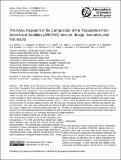| dc.contributor.author | Jacob, Daniel James | |
| dc.contributor.author | Crawford, J. H. | |
| dc.contributor.author | Maring, H. | |
| dc.contributor.author | Clarke, A. D. | |
| dc.contributor.author | Dibb, J. E. | |
| dc.contributor.author | Emmons, L. K. | |
| dc.contributor.author | Ferrare, R. A. | |
| dc.contributor.author | Hostetler, C. A. | |
| dc.contributor.author | Russell, P. B. | |
| dc.contributor.author | Singh, H. B. | |
| dc.contributor.author | Thompson, A. M. | |
| dc.contributor.author | Shaw, G. E. | |
| dc.contributor.author | McCauley, E. | |
| dc.contributor.author | Pederson, J. R. | |
| dc.contributor.author | Fisher, J. A. | |
| dc.date.accessioned | 2014-03-20T15:06:40Z | |
| dc.date.issued | 2010 | |
| dc.identifier.citation | Jacob, Daniel James, J. H. Crawford, H. Maring, A. D. Clarke, J. E. Dibb, L. K. Emmons, R. A. Ferrare, et al. 2010. “The Arctic Research of the Composition of the Troposphere from Aircraft and Satellites (ARCTAS) Mission: Design, Execution, and First Results.” Atmospheric Chemistry and Physics 10 (11) (June 14): 5191–5212. doi:10.5194/acp-10-5191-2010. http://dx.doi.org/10.5194/acp-10-5191-2010. | en_US |
| dc.identifier.issn | 1680-7316 | en_US |
| dc.identifier.issn | 1680-7324 | en_US |
| dc.identifier.uri | http://nrs.harvard.edu/urn-3:HUL.InstRepos:11957016 | |
| dc.description.abstract | The NASA Arctic Research of the Composition of the Troposphere from Aircraft and Satellites (ARCTAS) mission was conducted in two 3-week deployments based in Alaska (April 2008) and western Canada (June–July 2008). Its goal was to better understand the factors driving current changes in Arctic atmospheric composition and climate, including (1) influx of mid-latitude pollution, (2) boreal forest fires, (3) aerosol radiative forcing, and (4) chemical processes. The June–July deployment was preceded by one week of flights over California (ARCTAS-CARB) focused on (1) improving state emission inventories for greenhouse gases and aerosols, (2) providing observations to test and improve models of ozone and aerosol pollution. ARCTAS involved three aircraft: a DC-8 with a detailed chemical payload, a P-3 with an extensive aerosol and radiometric payload, and a B-200 with aerosol remote sensing instrumentation. The aircraft data augmented satellite observations of Arctic atmospheric composition, in particular from the NASA A-Train. The spring phase (ARCTAS-A) revealed pervasive Asian pollution throughout the Arctic as well as significant European pollution below 2 km. Unusually large Siberian fires in April 2008 caused high concentrations of carbonaceous aerosols and also affected ozone. Satellite observations of BrO column hotspots were found not to be related to Arctic boundary layer events but instead to tropopause depressions, suggesting the presence of elevated inorganic bromine (5–10 pptv) in the lower stratosphere. Fresh fire plumes from Canada and California sampled during the summer phase (ARCTAS-B) indicated low \(NO_x\) emission factors from the fires, rapid conversion of \(NO_x\) to PAN, no significant secondary aerosol production, and no significant ozone enhancements except when mixed with urban pollution. | en_US |
| dc.description.sponsorship | Engineering and Applied Sciences | en_US |
| dc.language.iso | en_US | en_US |
| dc.publisher | European Geosciences Union | en_US |
| dc.relation.isversionof | doi:10.5194/acp-10-5191-2010 | en_US |
| dash.license | LAA | |
| dc.title | The Arctic Research of the Composition of the Troposphere from Aircraft and Satellites (ARCTAS) Mission: Design, Execution, and First Results | en_US |
| dc.type | Journal Article | en_US |
| dc.description.version | Version of Record | en_US |
| dc.relation.journal | Atmospheric Chemistry and Physics | en_US |
| dash.depositing.author | Jacob, Daniel James | |
| dc.date.available | 2014-03-20T15:06:40Z | |
| dc.identifier.doi | 10.5194/acp-10-5191-2010 | * |
| dash.authorsordered | false | |
| dash.contributor.affiliated | Jacob, Daniel | |


